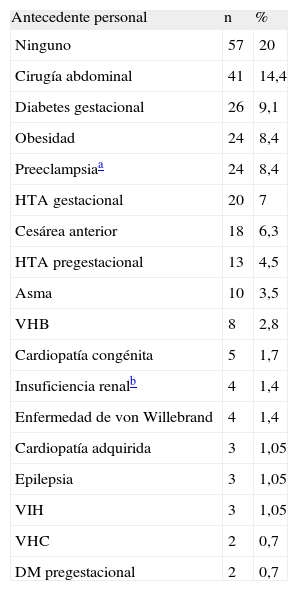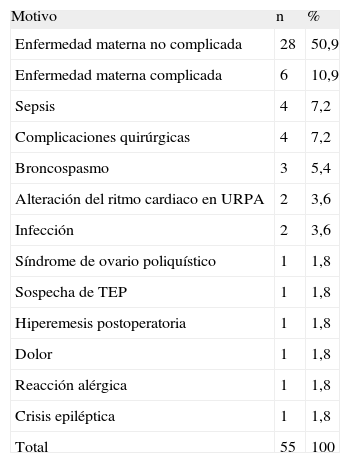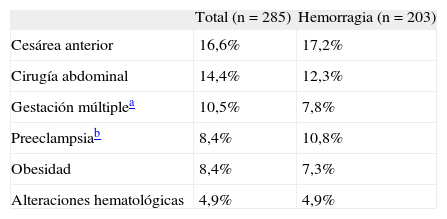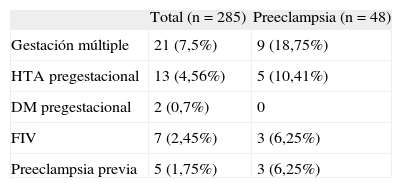Establecer el espectro de enfermedades de la paciente obstétrica que implican la estancia prolongada en la unidad de reanimación de un hospital maternal monográfico; analizar la gravedad de dichas alteraciones en función de las medidas requeridas para su resolución, así como identificar los factores que influyen en la morbilidad del postopera-torio de la paciente obstétrica.
Material y métodosSe revisan todas las historias clínicas de todas pacientes que ingre-saron en la Unidad de Reanimación del Hospital Universitario Maternal La Paz durante el año 2008, y se selecciona a las que requirieron un ingreso más largo de lo habitual, es decir, más de 6h tras una cesárea y todo ingreso que se produjera durante la gestación o tras un legrado o el parto.
ResultadosDe un total de 10.419 nacimientos que se produjeron en 2008, 3.000 pacien-tes obstétricas pasaron por la Unidad de Reanimación del Hospital Maternal, de las que 285 (9,5%) necesitaron cuidados críticos. La causa más frecuente de la estancia prolon-gada fue la hemorragia obstétrica, seguida de los estados hipertensivos del embarazo. Ninguna paciente obstétrica falleció en esta unidad en 2008.
ConclusionesLa cifra de pacientes que tuvieron que prolongar su estancia en la Reani-mación del Hospital Maternal es similar al porcentaje de pacientes graves obstétricas que ingresan en unidades de cuidados intensivos de países como Canadá o Reino Unido, pero con una mortalidad menor en nuestro servicio en el año evaluado. Las principales causas son la hemorragia obstétrica y los estados hipertensivos del embarazo. Por ello, se debe vigilar y monitorizar a las pacientes con factores de riesgo de sufrir estas com-plicaciones.
To establish the spectrum of diseases in the obstetric patient that involves an increase in the length of stay in the Recovery Unit of a specialist Maternity Hospital. To analyse the severity of these conditions as regards the means required for their resolu-tion, as well as to identify the factors that influence on post-operative morbidity in the obstetric patient.
Material and methodsAll the case histories of all the patients admitted to the Maternity Hospital Recovery Unit during the year 2008 were reviewed. Those who required a lon-ger stay than usual were selected, which included, those with more than 6hours after a caesarean, and all admissions made during pregnancy, or after dilation and curettage or partum.
ResultsOut of a total of 10419 births delivered in 2008, 3000 obstetric patients were ad-mitted to the Maternity Hospital Recovery Unit, of which 285 (9.5%) required critical care. The most frequent cause of increased length of stay was obstetric haemorrhage, followed by hypertensive states of pregnancy. No patients died in this Unit in the year 2008.
ConclusionsThe number of patients who had an increased length of stay in the Mater-nity Hospital Recovery Unit is similar to the percentage of patients who are admitted to Intensive Care Units in countries such as Canada or the United Kingdom, but our Unit had a lower death rate in the year evaluated. The main causes are obstetric haemorrhage and hypertensive states of pregnancy, thus patients with risk factors for developing these complications must be observed closely and monitored.
Artículo
Comprando el artículo el PDF del mismo podrá ser descargado
Precio 19,34 €
Comprar ahora











